The Health Education Assets Library (HEAL) is a collection of over 22,000 freely available digital materials for health sciences education. The collection is now housed at the University of Utah J. Willard Marriott Digital Library.
TO
Filters: Collection: "ehsl_heal"
| Title | Description | Subject | Collection | ||
|---|---|---|---|---|---|
| 951 |
 |
Ingrown nail | I use a curette to scrape back in the cul-de-sac beneath the proximal nail fold to physically remove all of the nail matrix I can. | Surgical Methods | Knowledge Weavers Dermatology |
| 952 |
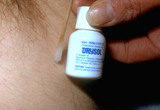 |
Skin tags | This shows Drysol being applied to the site of the skin tag removal to staunch bleeding. The Drysol hurts more than the snipping in my estimation. | Skin Tags | Knowledge Weavers Dermatology |
| 953 |
 |
Scalpel | The #15 blade and other small blades should be used by holding the scalpel handle as one holds a pencil. | Knowledge Weavers Dermatology | |
| 954 |
 |
Impetigo | Infection just beneath the stratum corneum of streptococcus or staphylococcus is called impetigo. The stratum corneum is readily torn off, and generally the serous ooze from the dermal blood vessels dries on the skin and produces a honey-colored crust. | Knowledge Weavers Dermatology | |
| 955 |
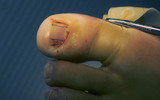 |
Ingrown nail | The portion of the nail plate that is to be removed is marked. | Knowledge Weavers Dermatology | |
| 956 |
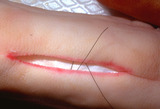 |
Excision procedure | This demonstrates the deep dermal suture ends that are exiting from the wound, and the order is crucial: loop-short-long. The long end is the needle bearing end. | Knowledge Weavers Dermatology | |
| 957 |
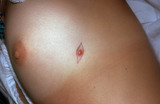 |
Dermatofibroma | A benign growth called dermatofibroma. It can look like a nevus, but it feels rock hard to the touch. | Knowledge Weavers Dermatology | |
| 958 |
 |
Bees | The sting of bees or wasps is a cause of anaphylaxis. | Knowledge Weavers Dermatology | |
| 959 |
 |
Scalpel | This cross-section shows the angles that are left on the edges that will allow for excellent eversion or puckering of the wound when the wound is closed. | Knowledge Weavers Dermatology | |
| 960 |
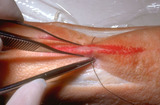 |
Suturing | This demonstrates the vertical mattress suture as it first entered the skin. I enter and exit the skin approximately 2 mm away from the wound edge, and I penetrate about halfway down into the underlying dermis. The important point is that the needle should be the same distance from the wound edge on... | Knowledge Weavers Dermatology | |
| 961 |
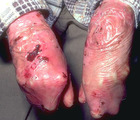 |
Scarring | Scarring occurs at sites where the epidermis tears off, and the digits normally scar together. | Knowledge Weavers Dermatology | |
| 962 |
 |
Rosacea | Patient with moderate Stage 2 rosacea. | Knowledge Weavers Dermatology | |
| 963 |
 |
Ectodermal dysplasia | This patient has ectodermal dysplasia. The patient lacks normal body hair on the scalp. | Knowledge Weavers Dermatology | |
| 964 |
 |
Suturing | A double loop is placed around the needle holder. | Knowledge Weavers Dermatology | |
| 965 |
 |
Excision procedure | The suture is wrapped twice around the needle holder and the short arm of the suture is then grasped, and | Knowledge Weavers Dermatology | |
| 966 |
 |
Keloid | Once the keloid is anesthetized, the corticosteroid should be injected directly into the middle of the keloid until the keloid blanches. I find it easiest to advancethe needle to the tip of the keloid, and then as I withdraw the needle I inject into the canal that I have created with the needle. I d... | Knowledge Weavers Dermatology | |
| 967 |
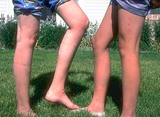 |
Mosquito bites | Mosquito bites. These are the legs of my sister and her daughter, and both develop an exaggerated insect bite reaction, which consist of striking swelling and itching, and it is much more pronounced than the average mosquito bite. | Knowledge Weavers Dermatology | |
| 968 |
 |
Suturing | A single loop is placed around the needle holder as shown. | Knowledge Weavers Dermatology | |
| 969 |
 |
Vasculitis | More severe damage to capillary sized vessels allows a significant amount of red blood cells and fluid to leak into the surrounding dermis, and this condition is called vasculitis. This is small vessel (capillary) vasculitis. | Knowledge Weavers Dermatology | |
| 970 |
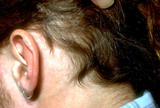 |
Androgenetic alopecia | Androgenetic alopecia often induces fine curly hair along the lateral margins of the scalp. | Knowledge Weavers Dermatology | |
| 971 |
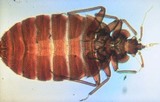 |
Bedbug | These are about 5 mm or more in length, are easily visible, but can be hard to flush out. | Knowledge Weavers Dermatology | |
| 972 |
 |
Ticks | The most common tick-borne disease in this area is Colorado Tick Fever, and second would be Rocky Mountain Spotted Fever, and rarely Tick Paralysis. The organism that causes Lyme disease (Borrelia burgdorferi) has not been shown to be carried by ticks in Utah. | Knowledge Weavers Dermatology | |
| 973 |
 |
Excision procedure | This demonstrates the 45 o angle in cross-section as one cuts through the dermis. | Surgical Methods | Knowledge Weavers Dermatology |
| 974 |
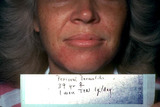 |
Paraorificial dermatitis | periorificial dermatitis induced by the application of Vaseline to facial skin; it has been treated for one month with 1 gram of tetracycline per day. | Knowledge Weavers Dermatology | |
| 975 |
 |
Scalpel | The blade should be slid on the handle until it locks into place. | Knowledge Weavers Dermatology |
